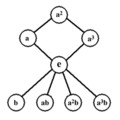ABE Math Tutorials/Whole numbers/Setup problems
Setup problems
| Whole numbers |
Introduction | Place value | Rounding | Long addition & subtraction | Long Multiplication | Long division | Expressing operations | Word problems | Order of operations | "Set-up" problems | Cost and distance problems | Introduction to algebra | Powers of 10 | Estimation | Not enough info | Homework
|
Fortunately, for many of the questions on the GED Math test, you don't actually have to do the arithmetic: you just have to know what to do -- how you would "set up" the problem. Here is an example of what you might see on the test:
Margaret sells baked goods at her local Farmer's Market. She sells bread for $2 a loaf, and pies for $3 each. Which expression below represents how much money she will earn if she sells 25 loaves of bread and 22 pies?
- 25 + 22
- 2 + 3
- (2) + 22(25)
- 2(25) + 3(22)
- 3(25) + 2(22)
You're asked "how much money" she will earn, so you know that you can't just add up the pies and loaves and expect to get the right answer. So answer choice #1 is obviously wrong. And look atanswer choice #2: it doesn't seem right that Margaret would make only $5 for selling all those pies and loaves of bread. What we're really going to have do is to multiply the number of loaves by the price she got for each one; and add that to the number of pies multiplied by the price she got for each one of those.
You can see that answer choice #4 shows the right way: 2 x 25 (for the 25 loaves of bread at $2 per loaf) plus 3 x 22 (for the 22 pies at $3 per pie) (2 x 25) + (3 x 22) or, written another way, 2(25) + 3(22)Ready to try a few?
Juan is a computer salesman. He earns $400 per week, plus a commission of $200 for each computer he sells. Which expression below represents his earnings for a week in which he sold 3 computers?
The Smithson Furniture factory had a staff of 500 people. For summer, they hired on an additional 40 people. In the winter, they laid off 65 people. Which expression below represents the number of staff at the Smithson factory now?
Sarina bought 5 dozen eggs on sale. On the way home, 7 of the eggs broke. Which expression below represents how many eggs she has left?
|
And now the answers:
|
If you're ready for the Setup Problems homework, click here.
